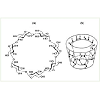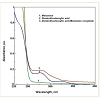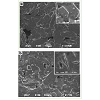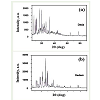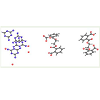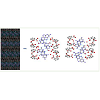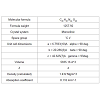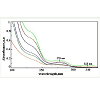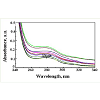Research Article
Spectroscopic Studies on Diester-Dicarboxylic Acid(DEDA) -Melamine Cocrystal and Its Inclusion Complex with β-Cyclodextrin
Ritty Alex1, Y. Sameena1, G. Tamil Selvan1, I. V. M. V. Enoch1, R. Arunachalam2, P.S. Subramanian2, E.Suresh3, P and P. MosaeSelvakumar1*
Corresponding author: Dr. P. Mosae Selvakumar, Department of Chemistry, Karunya University, Coimbatore-641 114,India,; E-mail: mosae@karunya.edu
Citation: Alex R, Sameena Y, Selvan GT, Enoch IVMV, Arunachalam R, et al. Spectroscopic Studies on Diester-Dicarboxylic Acid(DEDA) -Melamine Cocrystal and Its Inclusion Complex with β-Cyclodextrin. J Chem Applied Biochem. 2014;1(1): 104.
Copyright © 2014 Mosae Selvakumar et al. This is an open access article distributed under the Creative Commons Attribution License, which permits unrestricted use, distribution, and reproduction in any medium, provided the original work is properly cited.
Journal of Chemistry & Applied Biochemistry
Submission: 03/07/2014; Accepted: 05/09/2014; Published: 08/09/2014
Reviewed & Approved by Dr. V. Vijayakumar,Professor, Centre for Organic and Medicinal Chemistry, VIT University, India
Abstract
The present work deals with the synthesis of diester-dicarboxylic acid (DEDA)-Melamine co-crystal, characterized using UV-Visible absorption, scanning electron microscope and X-ray diffraction techniques. Single crystal X-ray analysis is carried out to confirm the formation of DEDA-Melamine co-crystal. Phthalic anhydride is used as the main source for synthesising the diesterdicarboxylic acid.By desymmetrizing phthalic anhydride, diester-dicarboxylic acid is synthesised. The synthesised diesterdicarboxylic acids are used for the reaction with melamine to obtain diesterdicarboxylic acid-Melamine co-crystal. The host-guest chemistry of diesterdicarboxylic acid, Melamine and their DEDA-Melamine co-crystal with β- cyclodextrin is also explored.
Keywords: Diester-dicarboxylic acid; Melamine; co-crystal; Single crystal X-ray analysis; β-Cyclodextrin
Introduction
The therapeutic efficacy of many pharmaceuticals is influenced by its characteristics like poor bioavailability, aqueous solubility, and chemical stability. The poor characteristics of the drugs lead to lowering its market value [1]. Many efforts have been adopted to increase the market value of drugs by overcoming the undesired properties of the drugs [2,3]. Multi-component crystals e.g. solvates, hydrates, cocrystal, salts play an important role in the design of new solids particularly in the pharmaceutical area [1]. Among them, cocrystal has regained attention as attractive alternate solid forms for drug development. Cocrystal incorporates pharmaceutically acceptable guest molecules into a crystal lattice along with the Active Pharmaceutical Ingredients (API). Physiochemical properties of pharmaceuticals can also be improved by obtaining co-crystal usingco-crystallization [4-6].
Cocrystallization with pharmaceutically acceptable compounds does not affect pharmacological activity of API, but can improve physical properties, Such as aqueous solubility, hygroscopicity etc., [7-9]. Hydrogen bonds are the basis of molecular recognition phenomena in pharmaceutical systems and are responsible for the generation of families of molecular networks with the same molecular components (single component crystals and their polymorphs) or with different molecular components (multiple component crystals or cocrystal) in the crystalline state [10]. Knowledge of the intermolecular interactions and their effects on crystal packingallowed for the engineering of co-crystals with desired physical and chemical properties.
Complexes resulting from entrapment of one compound in the molecular framework of other are considered as complexes of occlusion or inclusion complexes [11]. Directing a drug to the required site of action, targeting a specific receptor without undesired interactions at other sites, and controlled release of drugs can be achieved by the formation of host – guest assemblies [12]. Among the various host structures, Cyclodextrins (CDs) (nontoxic macrocyclic sugars) are molecular receptors studied extensively for their complexation behaviour [13]. CDs have unique physicochemical properties such as good water solubility, low toxicity and low immune response [14]. The interactions of many therapeutic small molecules with CDs have focused on their ability to form supramolecular complexes for the development of new drug dosage forms with an improved bioavailability and increased therapeutic efficacy together with reduced dosing frequency to minimize the side effects and to make more cost effective dosage form [15-16]. Structurally, CDs consist of 6, 7, or 8 (α, β, and γ respectively) D-glucopyranosyl units, connected by alpha-(1, 4) glycosidic linkages [17] and contain a hydrophobic central cavity and a hydrophilic outer surface with a significant number of hydrogen donors and acceptors. Hydrophilic cyclodextrins are considered non-toxic at low to moderate oral dosages. About 30 different pharmaceutical products containing CDs are now on the market worldwide and numerous food products, cosmetics and other commercial products contain CDs [18]. In these products CDs are mainly used as solubilizing agents to increase the water-solubility of lipophilic compounds. However, CDs can also be used to increase both the chemical and physical stability of various compounds, including proteins [19]. Cyclodextrin has also been used as tuner for the interaction of small molecules with DNA [20,21].
Anhydrides of aromatic acids are the precursor for various organic and supra-molecular syntheses. In the present work, phthalic anhydride is used as the main source for synthesising the diesterdicarboxylic acid (DEDA). P. Mosaeselvakumar et al. [22] deals that the synthesis of dicarboxylic bola-shaped compounds, possessing phthalyl head groups and diol spacers by desymmetrizing phthalic anhydride. Keeping phthalyl head group common for all three DEDA, the spacer moiety is systematically altered by two and four carbon atoms. The single crystal X-ray structure obtained for DEDA indicates the formation of self-assembled single stranded helical structure mediated through O–H…O interaction of the end carboxylic acid. According to World Health Organization, Melamine is not metabolized and is rapidly eliminated in the urine with a half life in plasma of around 3 hours (OECD 1998). The compound has a low acute toxicity, with an oral LD50 in the rat of 3161 mg/kg body weight (OECD 1998). No human data could be found on the oral toxicity of melamine. Melamine is a widely used industrial chemical not considered acutely toxic with a high LD (50) in animals [23].
The present work deals with the synthesis of diesterdicarboxylic-Melamine co-crystal from diesterdicarboxylic acid and melamine. The obtained co-crystal is characterized using various spectroscopic techniques. Single crystal X-ray Analysis is used as the main tool to confirm the DEAD-melamine co-crystal formation. The binding of DEDA, melamine, and their co-crystal with β-Cyclodextrin (Figure 1) is also explored.
Experimental Section
Synthesis
Preparation of Diester-dicarboxylic Acid [22] (2-({2-[(2-carboxybenzoyl)oxy]-ethoxy}carbonyl)benzoic acid, DEDA)
The DEDA is synthesised as given by P.Mosae selvakumar et al., using the pthalic anhydride (5.92 g, 0.04mol) and ethylene glycol (1.11 ml, 0.02 mol) in 2:1 ratio. It is characterised by Ultra-Violet Absorption (UV), Infra red (IR), Scanning Electron Microscope (SEM), X-Ray diffraction (XRD), 1H NMR, and 13 C NMR and Massspectroscopic techniques.
Preparation of DEDA-Melamine Cocrystal (DEDAM)
2:3 ratio of Melamine in water and DEDA in ethanol mixed together and heated (60°C) with stirring to become clear solution and kept it for crystallization. Colourless crystals were obtained after two days, characterised X-ray crystal studies used for confirmation of cocrystal formation. It is characterised by UV, SEM, XRD, X-Ray single crystal analysis techniques.
Preparation of solid inclusion complex of DEDA, Melamineand DEDAM with β-Cyclodextrin
DEDA, Melamine and DEDAM (0.01 M) was prepared in ethanol and an equimolar amount of β-CD was dissolved in doubly distilled water separately. A solution of DEDA, Melamine and DEDAM was added slowly to the solution of β-CD separately at room temperature in an Ultra-sonicator and maintained for 30 min. Then the mixture was warmed to 60°C for 10 min and kept at room temperature for two days. The colourless precipitate obtained was checked by TLC and analyzed by UV-Visible absorption and Scanning electron microscopic techniques.
Instrumentation
All the reactions are monitored by thin layer chromatography.Electronic spectra were recorded on a Jasco UV-630 spectrophotometer. IR spectra are recorded using KBr pellets on a Perkin–Elmer Spectrum GX FT-IR spectrometer. High-resolution mass analyses are performed using positive electron spray ionization(ESI) technique on a Water QT of micro mass spectrometer. 1H and 13C NMR spectra are recorded (500 and 125 MHz respectively) on a BRUKER Advance DPX 500 NMR spectrometer using CDCl3. The surface topology of the solid inclusion complex is imaged by JEOL Model JSM 6360 scanning electron microscope. The diffractionpattern of the crystal structure of the inclusion complex was reportedby Shimadzu XRD 6000 X-ray diffractrometer.
Single crystal X-ray analysis
A crystal of suitable size is selected and mounted on the tip of a glass fibre and cemented using epoxy resin. Intensity data for both crystals are collected using Mo-K (= 0.71073Å) radiation on a Bruker SMART APEX diffractometer equipped with CCD area detector at 100K. The data integration and reduction are processed with SAINTsoftware [24]. An empirical absorption correction are applied to the collected reflections with SADABS [25]. The structures are solved by direct methods using SHELXTL [26] and are refined on F2 by the full-matrix least-squares method using the SHELXL-97 [27] package. Graphics are generated using PLATON and MERCURY 1.3[Mercury 1.3 Supplied with Cambridge Structural Database; CCDC: Cambridge, U.K., 2003-2004]. All non-hydrogen atoms are refined anisotropically till convergence is reached. Hydrogen atoms are fixed at idealized positions steriochemically.
Chemicals and Working solutions
All chemicals are of commercial quality (Aldrich) and are used as received. All reagents and solvents used are of spectral grade which are used without further purification.β-Cyclodextrin is purchased fromHi-Media, India. Working solutions for the inclusion of molecules with β-CD are prepared by appropriate dilution of a stock solution of DEDA, Melamine and DEDAM and/or β-CD. The test solutions are having the concentration of ethanol as 3 %. Doubly distilled water was used throughout. All experiments are carried out at an ambienttemperature of 25 ± 2°C. The test solutions are homogeneous after all additives were added and the absorption are recorded against appropriate blank solutions.
Results and Discussion
Interaction between DEDA and Melamine for the formationof DEDAM, a co-crystal
The interaction of diesterdicarboxylic acid with melamine molecule is characterised by UV-Visible absorption technique. The UV-Visible electronic spectra recorded in ethanol for all these compounds shown in Figure 2. The electronic spectrum for all of these compounds behaves very similar in UV region and showscharacteristic band at 240-280 which is corresponds to π-π* transitions. The absorption maximum, λmax of Melamine is found as 275 nm (Figure 2) shows the existence of n-σ* and n-π* transition that takes place during the excitation of ground state electron of Melamine by UV light. The absorption maximum, λmax of diesterdicarboxylic acid is found as 278 nm. The n-σ*, n-π* and π-π* transition occurrence can be seen for diesterdicarboxylic acid molecules excitation. The interaction of Melamine to diesterdicarboxylic acid resulted into the shift of the absorption maxima of diesterdicarboxylic acid towards considerable red region with the increase in the absorbance of diesterdicarboxylic acid, which shows the existence of hydrogen bonding between Melamine and diesterdicarboxylic acid. The difference in the Morphology of the diesterdicarboxylic acid and diesterdicarboxylic acid-Melamine cocrystal is also observed (Figure 3 (a) and (b)). DEDA shows clumps of rectangular shaped crystals with the approximate width of ~10 μm , whereas DEDAM cocrystal exhibit clumps (rod like shape) with the width of ~ 5μm.
The XRD pattern of the DEDA and DEDAM is given in Figure 4. DEDA contains of a number of intense peaks, indicating the sharp crystal structures of the compound. The three strongest peaks observed are at 2θ, 16.87, 19.54 and 32 degrees. Similarly, DEDAM also contains a number of intense peaks, indicating the sharp crystal structures of the complex. The three strongest peaks observed are at 2θ, 26.06, 21.6 and 28.88 degrees for DEDAM. Using Debye-Scherrer formula (as given in Equation (1)), the average size of the crystals of DEDA and DEDAM are calculated as 27 and 21 nm respectively.
D = 0.9 λ/(β cos θ) (1)
Where D is the size of the crystal, λis the wavelength of the radiation,(=1.5418 Å), θ is the diffraction angle, and β is the broadening factor (half width measured at half its maximum intensity).
309 ORTEP diagram with atom numbering scheme for this cocrystal depicted in Figure 5 and the packing diagram of the same depicted in Figure 6. The crystal structures data is available in Table 1. The flexibility at the central - CH2-CH2-spacer and an intern molecular H-bonding influenced COOH-NH2 units are observed.while the intermolecular interaction bringing two molecules through the terminal carboxylic acid and amine into closer contact the carboxylate groups are locked with intermolecular H- bonding interaction with almost parallel with little twist on the corresponding phenyl rings are oriented almost perpendicular. Supramolecular assembly through N-H…O Hydrogen bonding interactions plays important role in building the cocrystal structure. Functional groups involved in hydrogen bindings are amine, acid and ester .Water molecules are encapsulated in crystal lattice. Hydrogen bonding is the driving force for co crystal formation.
Binding of Deda and its Melamine cocrystal, Dedam with β- Cyclodextrin
The inclusion complexation of Melamine with β-cyclodextrin (β-CD) was characterized by UV-Visible adsorption spectroscopy. The concentration of Melamine was fixed at 1×10-3, M.
The addition of β-CD from 0 M to 0.8 ×10-2 M results into the enhancement in the absorbance of Melamine in the absorption maximum λmax of 275 nm. The absorption maximum which is not prominent in the absence of β-CD became prominent considerably with the addition of β-CD. This shows the interaction of Melamine with β-CD.
In the case of the interaction of diesterdicarboxylic acid with β-CD, the concentration of DCA is fixed at 1×10-3, M. The addition of β-CD from 0, M to 1×10-2 M results into the decrease in the absorbance of DEDA in the absorption maximum λmax of 278 nm (Figure 7). The absorption maximum is prominent in the absenceof β-CD. In the presence of β-CD, DEDA shows more prominent band with the increase in the concentration of β-CD. This shows the interaction of DCA with β-CD. The cocrystal (3.41×10-4 M) also interacted with β-CD which exhibited increase in the absorbance of cocrystal ( Figure 8). The change in the absorbance of cocrystal showsthe interaction of the molecules present in cocrystal with β-CD. The absorption maximum is observed at 279 nm for the cocrystal.
SEM images of DEDA-β-CD, Melamine-β-CD and DEDAM-β-CD inclusion complexes are shown in Figure 9. It shows the difference in the surface morphology of the inclusion complex with respect to DEDA, Melamine and DEDAM co-crystal. The structures are more ordered in the case of DEDAM cocrystal.
Conclusion
Hydrogen bonding is the driving force for the co-crystal formation. The functional groups involved in hydrogen bonding interactions are amine, acid and ester groups. Supramolecular assembly through N-H…O hydrogen bonding interactions between amine hydrogen atom of Melamine and oxygen atom of carboxylic acids plays a role in building the diesterdicarboxylic acid-Melamine co-crystal structure. It is found that the water molecules are encapsulated in crystal lattice. The average crystallite size of DEDAM is calculated as 21 nm. Thehost-guest inclusion complexation of diesterdicarboxylic acids, melamine and their co crystals with β- cyclodextrin is explored.
Acknowledgement
Authors RA and PMSK acknowledge Tamilnadu state council for science and technology (TNSCST) and Karunya University for providing financial support.
References
- Sekhon BS (2009) Pharmaceutical co-crystal - a review. ARS Pharm 3: 99-117.
- Huttunen KM, Raunio H, Rautio J (2011) Prodrugs-from Serendipity to Rational Design. Pharmacol Rev 3:750-771.
- Lin JH, Lu AY (1997) Role of Pharmacokinetics and metabolism in drug discovery and development. Pharmacol Rev 49: 403-449.
- Shan N, Zaworotko MJ (2008) The role of co-crystal in pharmaceutical science. Drug Discov Today; 13:440-446.
- Trask AV, Motherwell WDS, Jones W (2006) Physical stability enhancement of theophylline via co-crystallization. Int J Pharm 320: 114-123.
- Jones W, Motherwell WD, Trask AV (2006) Pharmaceutical co-crystal: An Emerging approach to physical property enhancement. MRS Bull: 31:875-879.
- Zaworotko M (2008) Crystal engineering of co-crystal and their relevance to pharmaceuticals and solid-state chemistry. Acta Cryst; A64: C11-C12.
- Sun CC, Hou H (2008) Improving mechanical properties of caffeine and methyl gallate crystals by Co-crystallization. Cryst Grow Des 8: 1575-1579
- RodrÃguez-Hornedo N, Nehm SJ, Jayasankar A(2006) Cocrystals: design, properties and formation mechanisms, In Encyclopedia of Pharmaceutical Technology, Third edition, Taylor & Francis, London 615-635.
- Mahato RI, Narang AS (2012) Pharmaceutical dosage forms and drug delivery, 2nd Edition,Taylor and Francis Group, LLC.
- Mahato RI, Narang AS (2012) Pharmaceutical dosage forms and drug delivery, 2nd Edition,Taylor and Francis Group, LLC.
- Roongnapa Suedee (2013) Novel Strategic Innovations for Designing Drug Delivery System Using Molecularly Imprinted Micro/Nanobeads. Int J Pharm Sci Rev Res 44: 235-268.
- Yu Liu , Yong Chen(2006) Cooperative binding and multiple recognition by bridged Bis (β-cyclodextrin)s with functional linkers. Accounts of Chemical Research 39: 681-691.
- Volodymyr I. Rybachenko (2011) Molecular Receptors, Collected research papers, Donetsk, East Publisher House.
- Reddy Ik, Mehva R (2004) Chirality in Drug Design and Development, Marcel Dekker, Inc, New York.
- Kapetanovi IM (2011) Drug Discovery and Development - Present and Future, Published By Intech Janeza Trdine Rijeka, Croatia.
- Lakowicz JR (2011) Principles of fluorescence spectroscopy. 3rded.; New York: Plenum.
- Durga Devi N, Prameela AR, Javed MM, Kumar S K, Kaushik J, et al. (2010) Cyclodextrins In Pharmacy- An Overview. Pharmacophore 3: 155-165.
- Anjana MN, Nair SC, Joseph J (2013) An Updated Review of Cyclodextrins -an enabling technology for challenging pharmaceutical formulations. International Journal Of Pharmacy And Pharmaceutical Sciences 5: 54-58.
- Yousuf S, Israel V. M. V. Enoch (2012) Spectroscopic investigation of interaction of 6-methoxyflavanone and its β-cyclodextrin inclusion complex with calf thymus DNA. Chemical Papers 66: 787-794.
- Selvakumar MP, Suresh E, Waghmode S , Subramanian PS (2011) Synthesis, structure, EPR, and DFT calculation on dinuclear paddle wheel Cu(II) complexes with bis-chelate rings. Journal of Coordination Chemistry 64: 3495-3509.
- Skinner CG, Thomas JD, Osterloh JD (2010) Melamine toxicity. J Med Toxicol 6: 50-55.
- Yadav AV, Shete AS, Dabke AP, Kulkarni PV, Sakhare SS (2009) Co-crystals: A novel approach to modify physicochemical properties of active pharmaceutical ingredients. Indian J Pharm Sci 71: 359-370.
- Einspahr H, Bugg CE (1981) The geometry of Calcium-Carboxylate interactions in crystalline complexes. Acta Cryst B37: 1044-1052.
- Strothkamp KG, Lippard SJ (1982) Chemistry of the imidazolate-bridged bimetallic center in the Cu-Zn superoxide dismutase and its model compounds. S J Acc Chem Res 15: 318-326.
- Wesemann JL, Chisholm MH (1997) Incorporation of Ru(2)(O(2)C(CH(2))(6)CH(3))(4) into Extended Chains: Interaction of Ru(2)(O(2)C(CH(2))(6)CH(3))(4) with Pyrazine, 4-Cyanopyridine, TCNE, and p-Benzoquinone. Inorg Chem 36: 3258-3267.
- Lawton D, Masan RJ (1965) The Molecular Structure of Molybdenum (II) Acetate. J Am Chem Soc: 87: 921-922.

